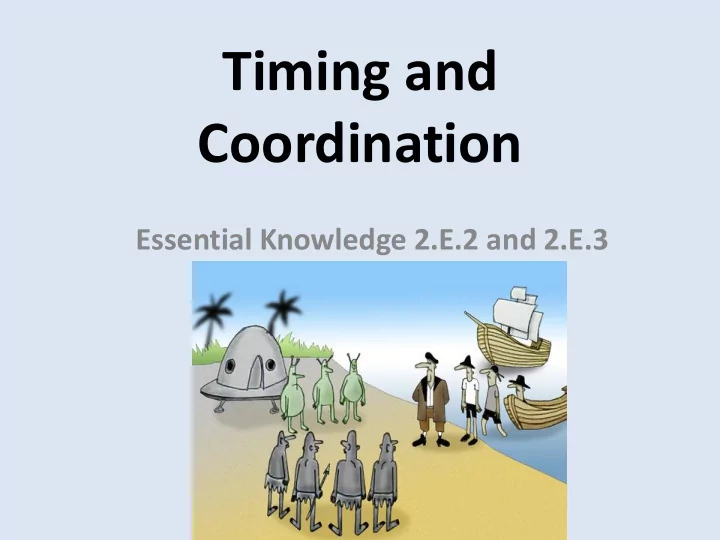

Timing and Coordination Essential Knowledge 2.E.2 and 2.E.3
Timing and Coordination • Timing and coordination of physiological events are regulated by multiple mechanisms ( 2.E.2 ) • Timing and coordination of physiological events are regulated by various mechanisms and are important in natural selection ( 2.E.3 )
Essential Knowledge 2.E.2 Timing and coordination of physiological events are regulated by multiple mechanisms
Timing and coordination of physiological events are regulated by multiple mechanisms Examples of physiological events that involve timing and coordination: • Plants – phototropism, photoperiodism • Animals – hibernation • Fungi – fruiting body formation • Bacteria – quorum sensing
Plants • In plants, physiological events involve interactions between environmental stimuli and internal molecular signals • Examples include phototropism and photoperiodism
Phototropism • Response to the presence of light – grow towards or away from light • Growth is triggered by auxin hormones located within cells on the dark side of the shoot
Phototropism
Photoperiodism • Response to change in length of the night , that results in flowering in long-day and short- day plants • Anticipate the seasons in order to flower at the correct time of year • Involves a pigment called phytochrome (protein that acts as a photoreceptor)
Photoperiodism
Photoperiodism
Animals • Internal and external signals regulate a variety of physiological responses that synchronize with environmental cycles and cues
Circadian Rhythms • The physiological cycle of about 24 hours that is present in all eukaryotes and persists even in the absence of external cues • Controlled by genetics and amounts of light and darkness • Jet lag is a common circadian rhythm disruptor in humans
Circadian Rhythms • Characterized by rising and falling hormone levels, undulating body temperature, and the familiar sleep-wake cycle • Pineal gland plays a role by secreting the hormone melatonin
Hibernation • A state of inactivity and metabolic depression characterized by lower body temperature, slower breathing, and/or lower metabolic rate • Conserves energy when food supplies are limited • Obligate hibernators, facultative hibernators, torpor
Hibernation • Obligate – driven by internal mechanisms, “true hibernators” • Facultative – can be aroused by external stimuli • Torpor – temporary hibernation
Fungi • Internal and external signals regulate a physiological response known as fruiting body formation that synchronizes with environmental cycles and cues
Fruiting Body Formation • Spore-producing structure (often referred to as a mushroom) • Influenced by temperature, air humidity, nutrients and light
Bacteria • Use quorum sensing to coordinate behavior and communicate based on population density
Quorum Sensing (How Bacteria “Talk” – TED Talk – 18 minutes) • A system of stimulus and response correlated to population density • Used to coordinate gene expression and, through signal transduction, can influence the behavior of the entire community
Essential Knowledge 2.E.3 Timing and coordination of physiological events are regulated by various mechanisms and are important in natural selection
Timing and coordination of physiological events are regulated by various mechanisms and are important in natural selection Examples of mechanisms that are important in natural selection: • Innate and learned behaviors • Responding to information and communication of information • Cooperative behavior
Innate and Learned Behaviors • Individuals can act on information and communicate it to others • Innate behaviors are behaviors that are inherited (natural selection) • Learned behaviors occur through interactions with the environment and other organisms (natural selection
Innate Behaviors
Learned Behaviors • Associative learning • Habituation • Cognition and problem solving
Response to Information and Communication • Responses to information and communication of information are vital to natural selection • Examples: – Phototropism in plants, maximizes exposure of leaves for photosynthesis – Photoperiodism in plants, regulate flowering and preparation for winter – Courtship behavior and migration in animals
Courtship Behavior • Vital to reproduction, natural selection and survival of the species • Allows animals to distinguish between different species to ensure compatible mates
Migration • A regular long-distance change in location • Observed in a wide variety of birds, fish and other animals
Why do animals migrate? • Found in all major animal groups – birds, mammals, fish, reptiles, amphibians, insects and crustaceans • In search of food or more favorable living conditions when seasons change • To breed (mate and produce offspring)
Monarch Migration (Monarch Migration Video – 4 minutes)
Humpback Whale Migration
Cooperative Behavior • Cooperative behavior within or between populations contributes to the survival of the population Examples include: • Niche and resource partitioning • Mutualistic relationships
Niche and Resource Partitioning • Allows species to coexist within communities • Hunt for insects and nest in different areas of the same tree
Mutualistic Relationships • Both organisms benefit from the relationship
Recommend
More recommend